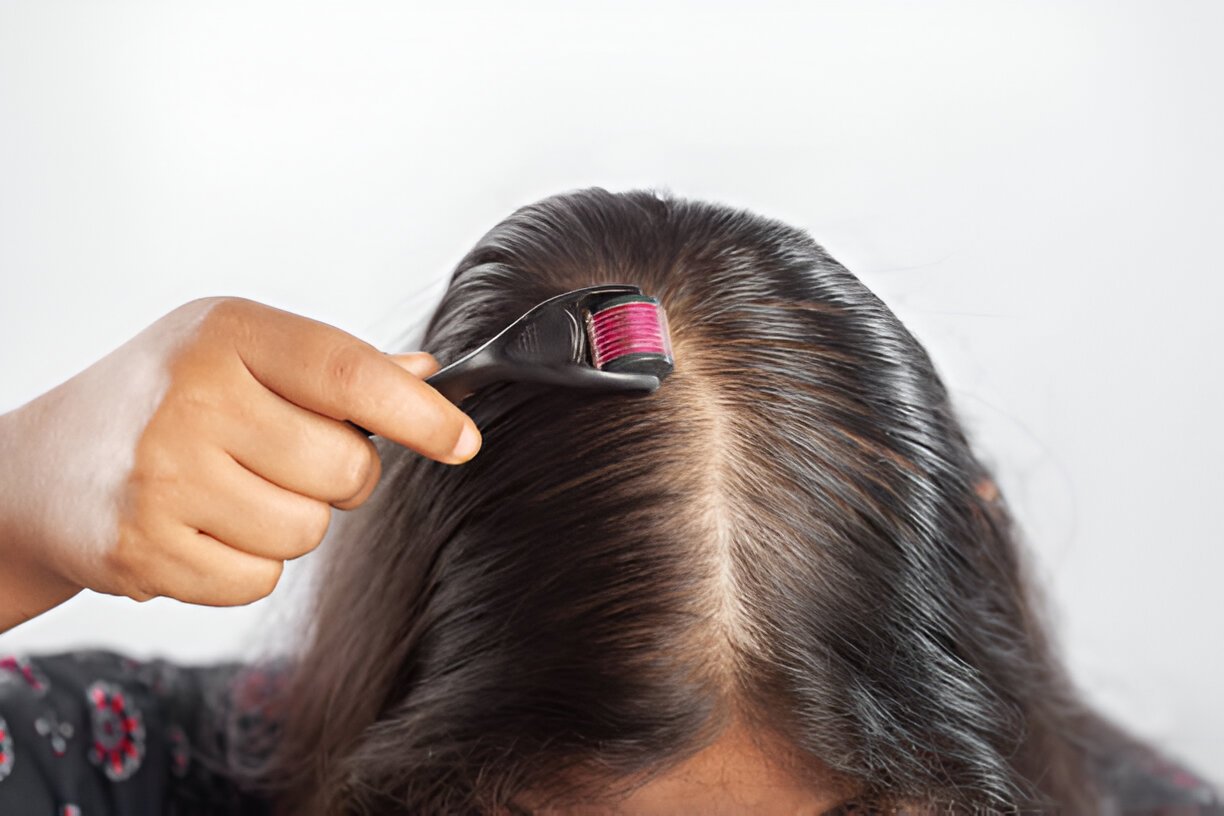As gray hair begins to appear, many individuals seek ways to seamlessly blend it with their natural dark brown color. The process roots how to blend grey hair with dark brown hair has become an art form, allowing people to embrace their changing locks while maintaining a polished look. This technique has gained popularity as a natural alternative to full coverage dye jobs, offering a more subtle and low-maintenance approach to hair color.
Gray blending for dark hair involves various methods and products designed to create a harmonious transition between shades. From highlighting techniques like babylights to the use of hair toners and purple shampoos, there are numerous options to achieve a natural-looking result. This article will explore the fundamentals of understanding gray and dark brown hair, effective highlighting strategies, the role of lowlights and color toning, and tips to maintain the blended appearance for long-lasting, beautiful results.
Understanding Gray Hair and Dark Brown Hair
The science behind hair color
Hair color is primarily determined by genetics and the production of melanin, a pigment that gives hair its hue. Melanin is produced by specialized cells called melanocytes, which reside at the base of each hair follicle. There are two types of melanin: eumelanin and pheomelanin. Eumelanin is responsible for dark colors, while pheomelanin contributes to warmer tones.
In dark brown hair, there is a higher concentration of eumelanin. The amount and ratio of these pigments are unique to each individual and are controlled by multiple genes. These genes can switch on and off at different points in life, which explains why hair color can change over time.
As people age, melanocytes gradually wear out or die, leading to a decrease in melanin production. This process results in the appearance of gray hair. A hair that receives little pigment appears gray, while one that gets no pigment at all looks white.
Challenges of blending gray with dark brown
Blending gray hair with dark brown presents several challenges due to the stark contrast between the two colors. Gray hairs stand out prominently against the darker background, making them more noticeable. This contrast can create an uneven appearance, especially during the transition phase.
Another challenge is the different textures of gray and pigmented hair. Gray hair tends to be coarser and more resistant to color treatments, which can make achieving a uniform look difficult. Additionally, the rate at which gray hair appears varies from person to person and can be influenced by factors such as genetics, stress, and certain health conditions.
To address these challenges, various techniques have been developed to create a more harmonious blend between gray and dark brown hair. These methods include highlighting, lowlighting, and color toning, which help to soften the transition and create a more natural-looking result.
Highlighting Techniques for Blending
When it comes to blending gray hair with dark brown, various highlighting techniques can create a seamless and natural look. These methods offer different approaches to achieve a harmonious blend between gray and pigmented strands.
Babylights
Babylights are an excellent option for those with minimal gray hair around the face or crown. This technique involves applying super-fine streaks of color to the topmost layer of hair. By doing so, it illuminates the overall hue and makes gray strands less noticeable. Babylights can brighten gray hair, giving it a more youthful appearance.
Balayage
For a more lived-in color that naturally blends with gray and base color, balayage is a popular choice. This hand-painted highlighting technique yields a natural-looking gradient effect. It helps to subtly connect gray roots to the rest of the hair color. The stylist applies a lightener to small sections of hair, hand-painting the strands up to the root. Smaller sections are used for areas with more grays. Balayage offers a more organic look, avoiding harsh lines of hair regrowth from the roots. It also allows for spot treatment of larger portions of hair.
Foil highlights
Traditional foil highlights provide a consistent blend of highlights and lowlights throughout the hair, starting at the roots. This method uses a lightener product or hair color applied to small sections of hair, which are then wrapped in foil. The foil traps warmth, helping to process hair lighteners and color more quickly. Foil highlights are particularly effective for ensuring coverage of every stray gray and diminishing a sharp line of gray root regrowth. However, this technique may require more frequent touch-ups to maintain the style.
For those seeking a combination of techniques, “foilyage” offers the best of both worlds. It combines the balayage technique with the use of foil, creating a natural and precise look. This method can be particularly beneficial for lightening darker hair due to the warmth generated by the foil.
ALSO READ:How to Tell if a Girl Likes You: Top 10 Signs to Watch
Lowlights and Color Toning
Adding depth with lowlights
Lowlights offer a unique approach to blending gray hair with dark brown. Unlike highlights, lowlights darken sections of hair by 1-2 shades, adding depth and dimension. This technique is particularly effective for those who want to cover their grays or create a subtle contrast with their silver streaks.
For a natural look, smokey brown lowlights can give hair depth without appearing overly styled. Those embracing their grays might opt for silver or gray lowlights, resulting in a trendy and stylish appearance. To create a dramatic effect, dark charcoal lowlights can make silver streaks stand out against the darker base color.
The choice of lowlight shade depends on the desired outcome and the individual’s base color. For brunettes to black hair, warm caramels, golden tones, and dark ashy colors like mushroom brown can add dimension without drawing too much attention to the grays. Rich shades such as mahogany, espresso, and chestnut work well as lowlights to enhance the base color.
Using toners to neutralize brassiness
Toners play a crucial role in neutralizing unwanted tones and achieving the desired hair color. Gray hair often appears dull or yellowed compared to natural color, but tint-correcting shampoos can help mask these unwanted hues. Using a toner, rather than a dye, can effectively cool off hair without pulling more color and potentially causing brassiness.
For those looking to make warm brown hair more ashy without bleaching, blue or purple toning shampoos or conditioners can be effective. These products neutralize brassy tones, shifting warm brown hair towards a cooler, ashier tone. Semi-permanent or demi-permanent hair color in an ash brown shade can also help neutralize warmth.
When selecting a toner, consider using a demi-permanent option at the same level as the hair color. A toner containing violet and green pigments can neutralize brassy tones and create a cooler brown. Green, being opposite to red on the color wheel, helps achieve a more natural or ashy look.
Wella toners, particularly T-18 or similar shades, are popular choices. Purple shampoo and conditioner can also be beneficial, as purple cancels out yellow tones while blue neutralizes orange tones. This color theory explains why these products are effective in maintaining the desired hair color.
Maintaining Your Blended Look
Blending gray hair with dark brown has become a sought-after technique to embrace natural changes while maintaining a polished look. This approach offers a more subtle and low-maintenance alternative to full coverage dye jobs. From babylights and balayage to foil highlights and lowlights, there are numerous methods to create a seamless transition between shades. These techniques, combined with the use of toners and color-correcting products, allow for a customized and natural-looking result.
The key to successful gray blending lies in understanding the science behind hair color and addressing the unique challenges posed by the contrast between gray and dark brown hair. By choosing the right combination of highlighting techniques, lowlights, and toning products, individuals can achieve a harmonious blend that enhances their natural beauty. This personalized approach not only results in a more natural appearance but also reduces the need for frequent touch-ups, making it a practical and stylish solution for those embracing their changing locks.
FAQs
- What are the steps to blend gray hair with dark brown? To blend gray hair with dark brown, consider techniques like babylights for subtle illumination, balayage for a natural gradient effect, or foil highlights for consistent coverage. Adding lowlights can enhance depth, while toners can help neutralize unwanted brassiness and achieve a cooler tone. Choose the method that best suits your desired look and maintenance preferences.
- How can I use lowlights to blend gray hair with dark brown? Lowlights darken sections of hair by 1-2 shades, creating depth and dimension. For a natural look, opt for smokey brown or silver lowlights. Rich shades like mahogany or chestnut can enhance your base color while blending grays. Lowlights can provide a subtle contrast and integrate gray strands more seamlessly with your natural color.
- What role do toners play in blending gray hair with dark brown? Toners help neutralize unwanted warm or brassy tones in gray hair. Using blue or purple toning shampoos or conditioners can shift warm brown hair towards a cooler, ashy tone. Toners balance the overall color, making gray hair blend more naturally with dark brown by correcting any discoloration.
- How often should I touch up my gray hair blend? The frequency of touch-ups depends on the method used and your hair’s growth rate. Techniques like balayage or babylights require fewer touch-ups due to their gradual blending effect. For high-maintenance looks like foil highlights, touch-ups every 6-8 weeks may be necessary. Regular use of toners can help maintain color between appointments.
- Can gray hair blending be done at home, or is it better to visit a salon? While some techniques like using toning shampoos can be done at home, more complex blending methods such as babylights, balayage, or foil highlights are often best performed by a professional stylist. A salon visit ensures precise application and desired results, particularly when achieving a seamless blend between gray and dark brown hair.
-
ALSO READ:How to Tell if a Girl Likes You: Top 10 Signs to Watch





One Comment